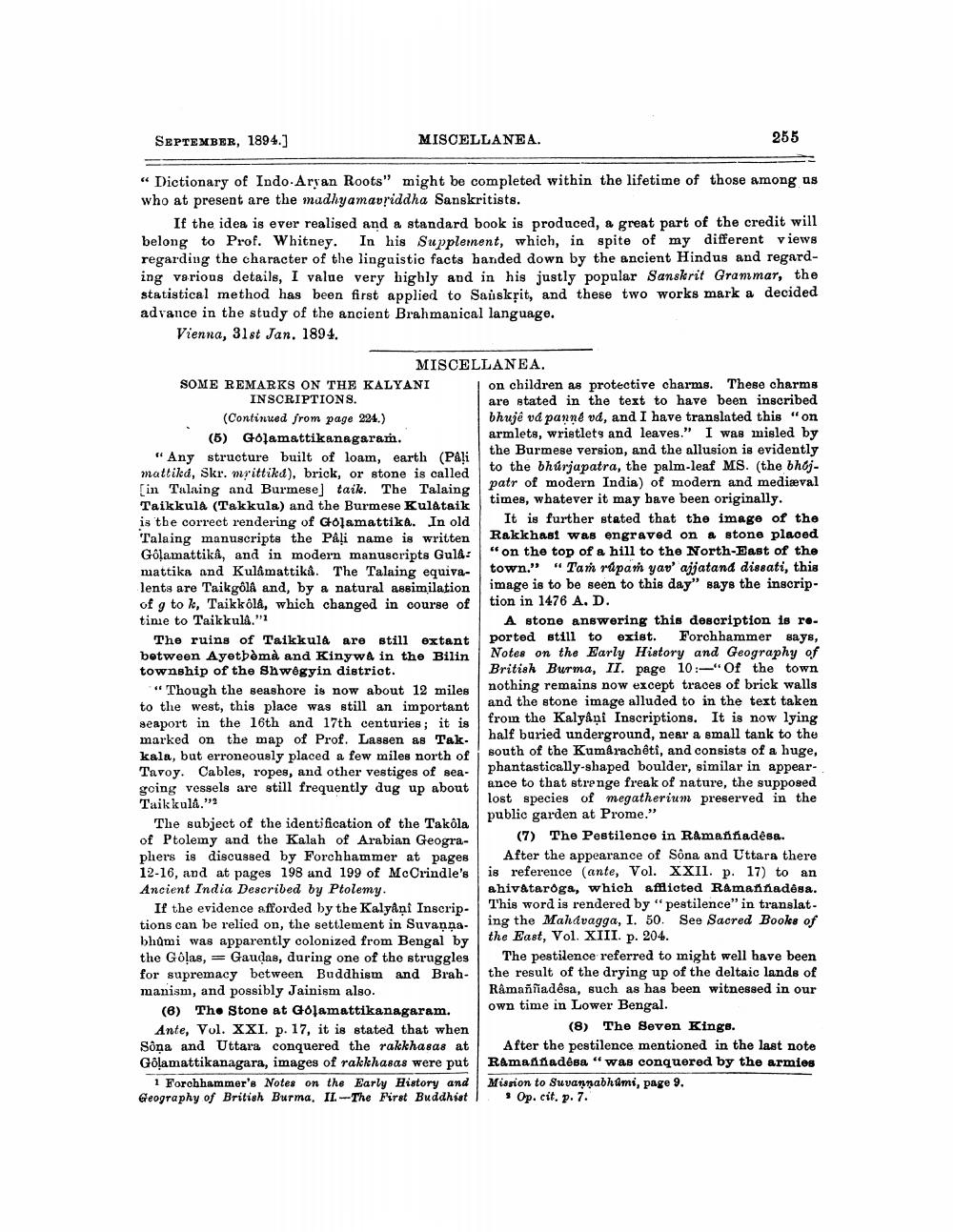________________
SEPTEMBER, 1894.]
MISCELLANEA.
"Dictionary of Indo-Aryan Roots" might be completed within the lifetime of those among us who at present are the madhyamavṛiddha Sanskritists.
If the idea is ever realised and a standard book is produced, a great part of the credit will belong to Prof. Whitney. In his Supplement, which, in spite of my different views regarding the character of the linguistic facts handed down by the ancient Hindus and regarding various details, I value very highly and in his justly popular Sanskrit Grammar, the statistical method has been first applied to Sanskrit, and these two works mark a decided advance in the study of the ancient Brahmanical language.
Vienna, 31st Jan. 1894.
MISCELLANEA.
SOME REMARKS ON THE KALYANI
INSCRIPTIONS.
(Continued from page 224.)
(5) Gólamattikanagaram.
"Any structure built of loam, earth (Pâli mattika, Skr. myittika), brick, or stone is called
[in Talaing and Burmese] taik. The Talaing Taikkula (Takkula) and the Burmese Kulataik
is the correct rendering of Golsmattika. In old Talaing manuscripts the Pâli name is written Gôlamattikâ, and in modern manuscripts Gula: mattika and Kulâmattika. The Talaing equivalents are Taikgôlâ and, by a natural assimilation of g to k, Taikkôla, which changed in course of time to Taikkula."
The ruins of Taikkula are still extant between Ayetbèmà and Kinywa in the Bilin township of the Shwegyin district.
"Though the seashore is now about 12 miles to the west, this place was still an important seaport in the 16th and 17th centuries; it is marked on the map of Prof. Lassen as Takkala, but erroneously placed a few miles north of Tavoy. Cables, ropes, and other vestiges of seagoing vessels are still frequently dug up about Taikkula."
The subject of the identification of the Takôla of Ptolemy and the Kalah of Arabian Geographers is discussed by Forchhammer at pages 12-16, and at pages 198 and 199 of McCrindle's Ancient India Described by Ptolemy.
If the evidence afforded by the Kalyani Inscriptions can be relied on, the settlement in Suvannabhumi was apparently colonized from Bengal by the Gôlas, = Gaudas, during one of the struggles for supremacy between Buddhism and Brahmanism, and possibly Jainism also.
255
(6) The Stone at Gólamattikanagaram. Ante, Vol. XXI. p. 17, it is stated that when Sona and Uttara conquered the rakkhasas at Gôlamattikanagara, images of rakkhasas were put
1 Forchhammer's Notes on the Early History and Geography of British Burma. II-The First Buddhist
on children as protective charms. These charms are stated in the text to have been inscribed bhuje vá panné vá, and I have translated this "on armlets, wristlets and leaves." I was misled by the Burmese version, and the allusion is evidently to the bhúrjapatra, the palm-leaf MS. (the bhojpatr of modern India) of modern and mediaval times, whatever it may have been originally.
It is further stated that the image of the Rakkhasi was engraved on a stone placed "on the top of a hill to the North-East of the town." "Tam rúpam yav' ajjatand dissati, this image is to be seen to this day" says the inscrip
tion in 1476 A. D.
A stone answering this description is reported still to exist. Forchhammer says, Notes on the Early History and Geography of British Burma, II. page 10:-"Of the town nothing remains now except traces of brick walls and the stone image alluded to in the text taken from the Kalyani Inscriptions. It is now lying half buried underground, near a small tank to the south of the Kumârachêti, and consists of a huge, phantastically-shaped boulder, similar in appearance to that strenge freak of nature, the supposed lost species of megatherium preserved in the public garden at Prome."
(7) The Pestilence in Ramaññadėsa. After the appearance of Sôna and Uttara there is reference (ante, Vol. XXII. p. 17) to an ahivataróga, which afflicted Ramaññadėsa. This word is rendered by "pestilence" in translating the Mahdvagga, I. 50. See Sacred Books of the East, Vol. XIII. p. 204.
The pestilence referred to might well have been the result of the drying up of the deltaic lands of Râmaññadêsa, such as has been witnessed in our own time in Lower Bengal.
(8) The Seven Kings.
After the pestilence mentioned in the last note Ramaññadésa "was conquered by the armies Mission to Suvannabhumi, page 9.
s Op. cit. p. 7.




